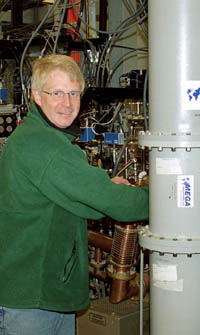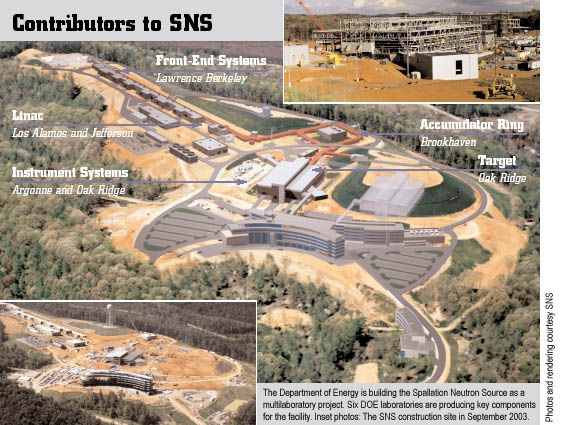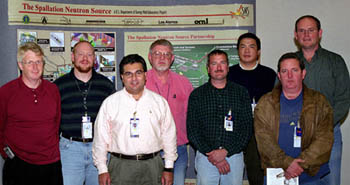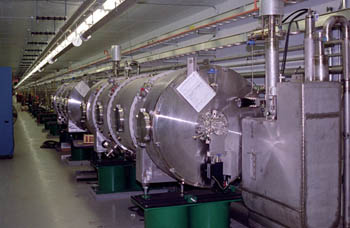 |
|
SNS: A Camera for Molecular Structures by Kurt Riesselmann From shatter-proof windshields to therapeutic drugs, from compact discs to cosmetics, many products have benefited from research with one of the building blocks of atoms: neutrons. Increasingly powerful neutron sources have paved the way for scientists to design and to produce new materials and better products with a wide range of applications.
In contrast to x-rays, which cannot penetrate metal or other dense materials, neutrons traverse more or less all types of material, shedding light on their internal structures. For example, neutrons have been crucial in understanding how bones mineralize during development and how they degenerate during osteoporosis, a bone-demineralizing disease. The results have allowed scientists to devise and to test treatments for osteoporosis and other diseases. "Increasingly, we are trying to master very complex materials: polymers, proteins, nanomaterials and superconductors, all of which are made of large molecules," said Thomas Mason, associate director for the Spallation Neutron Source currently under construction at Oak Ridge National Laboratory in Tennessee. "From a scientific point of view, what we need to understand is structure. Structure determines the properties of materials." The SNS, built by the Office of Science of the U.S. Department of Energy, will be the world's premier accelerator-based neutron source, surpassing existing machines in Europe and Japan. Unlike reactor-based neutron sources, the 1.4-megawatt SNS facility, scheduled to be completed in June of 2006, will create pulses of neutrons rather than a continuous stream. Scientists will use this capability to take quick snapshots and to make "movies" of molecules in motion.
To create neutrons, the SNS will use a 1,000-foot-long Linear Accelerator that delivers a proton beam of one GeV. An Accumulator Ring at the end of the Linac, 750 feet in circumference, receives the protons at close to the speed of light, merging and compressing them into a high-intensity proton pulse that can deliver all particles within less than a millionth of a second. Sixty times per second, the ring ejects a pulse ultimately containing more than 1014 protons, all of which hit a target container filled with mercury. "It's like a snowball hitting a wall," said Norbert Holtkamp, head of the SNS Accelerator Division. "Neutrons fly out in all directions."
The proton collisions knock neutrons out of the heavy mercury nuclei, a process called spallation. On average, each proton creates about 20 neutrons. In contrast to a nuclear reactor, a spallation neutron source creates no chain reactions. Operators can stop the neutron production at any time by simply switching off the linear accelerator that provides the proton beam.
MULTILABORATORY COLLABORATION
The remainder of the Linac features one of the big technological advances incorporated in the SNS design. Final acceleration will be achieved by superconducting RF cavities from Jefferson Lab. The cavities, cooled to 2 kelvins, have a larger aperture (beam opening) than conventional cavities, allowing higher beam intensities while reducing beam losses and residual radiation. The first three of 23 cryogenic modules, each containing three superconducting cavities, are now in the SNS Linac tunnel. Each cavity will receive power from a klystron produced in industry. Scientists expect to have the first beam passing through the entire SNS Linac in March 2005. When complete, the Linac will be the second largest RF installation in the world. The Accumulator Ring, which collects the protons, relies on equipment produced by BNL. The ring already has received 12 of the 32 modules needed to steer the proton beam around the ring and to shape its properties. Exiting the ring, the protons will fly through a small opening into the center of the target station constructed by ORNL. The target vessel is surrounded by 15 feet of steel and concrete. Twenty-four openings allow neutrons to escape the target area and to travel to a corresponding number of experimental areas surrounding the target station. ORNL and ANL are building five of the 24 instruments required for neutron measure-ments. The other instruments, at a cost of approxi-mately $10 million apiece, will come from scientific collaborations involving universities and other scientific institutions. So far, a total of 16 instruments have been approved, none of which involve classified research. Two of the instruments will come from collaborations in Canada and Germany.
Although Fermilab is not an official member of the SNS project, it provides significant expertise in form of employees and technical advice. At least 14 people working in the SNS Accelerator Division are former Fermilab employees, including Holtkamp. Since the SNS project includes the construction of the first large accelerator in the history of Oak Ridge National Laboratory, the influx of accelerator experts is more than welcome. Alan Jones, who joined Fermilab in 1972, now is breaking new ground as part of the SNS team. "The most exciting thing is to switch things on for the first time and see them running," he said. "Right now, we've got the SNS front-end systems running. We've produced beam." Of course, work at the scientific frontier on a not-yet-complete research campus has its challenges. "At Fermilab, there was a procedure for everything," said Mark Champion, recalling manuals and documentation associated with the scientific equipment at Fermilab. Champion, who has worked at several accelerator labs, also remembers another aspect that made work easy at Fermilab: "Fermilab has a great stockroom."
"The multi-laboratory SNS partnership will likely be a model for future large science projects," said Mason. "It will be a model for ITER, the Next Linear Collider, and other large science facilities listed in the 20-year DOE plan." On the Web:
Spallation Neutron Source
Oak Ridge National Laboratory |
| last modified 11/24/2003 email Fermilab |
FRLsDFx9eyfrPXgV





